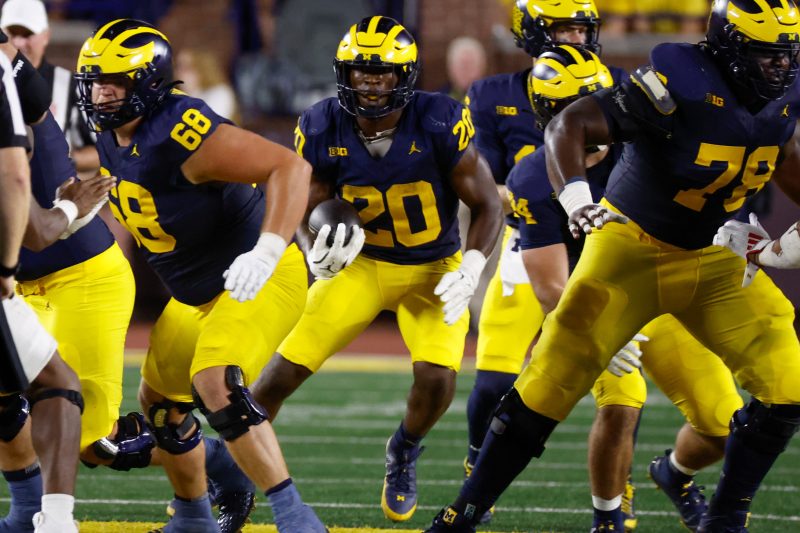
Breaking down the Michigan-Texas matchup and what’s at stake for both teams
Michigan and Texas have met only once before, but it was a doozy.
The 2005 Rose Bowl ranks comfortably among the greatest bowl games in modern history. Led by quarterback Vince Young, the Longhorns scored 17 points in the fourth quarter to win 38-37, with the winning points coming on a 37-yard field goal in the final seconds.
Twenty seasons later, these two powerhouse programs will face off in a high-profile non-conference matchup pitting two of the strongest teams from the two strongest leagues in the Bowl Subdivision.
Defending national champion Michigan has a new head coach, a new quarterback and new contributors on both sides of the ball. The No. 9 Wolverines started the year with an uneven win against Fresno State, leading to a one-spot drop in this week’s USA TODAY Sports US LBM Coaches Poll.
No. 3 Texas blanked Colorado State 52-0 in Week 1, getting off on the right foot after last year’s breakthrough under coach Steve Sarkisian. While also dealing with offseason attrition, the Longhorns’ roster looks like the strongest and deepest of the Sarkisian era — a very good thing given this season’s shift to the SEC.
These are the questions that will determine the final score and the bigger themes underscoring a matchup that will help define the course of the 2024 season:
What do we know about Michigan?
Not too much, except for this key fact: Michigan has won 16 games in a row, including 23 in a row at home.
All but one of those wins came under Jim Harbaugh, now the head coach of the Los Angeles Chargers. His replacement, former offensive line coach and offensive coordinator Sherrone Moore, is still working in Harbaugh’s shadow as he looks to place his fingerprints on the program.
Despite the massive changes since the win against Washington in January, the Wolverines are still constructed to be one of the best teams in the Big Ten and a strong candidate for the playoff. Defensively, Michigan are strong up the middle with interior lineman Mason Graham and sharp on the outside with cornerback Will Johnson, who iced the win against Fresno State with a pick-six.
But there are major question marks on offense. New quarterback Davis Warren, a former walk-on, went 15 of 25 for 118 yards with a touchdown and an interception against the Bulldogs. The Wolverines had just one drive traveling more than 47 yards, a 75-yard march in the fourth quarter to give them a 23-10 lead after Fresno State had pulled within a possession.
Overall, the 269 yards of offense were Michigan’s fewest in a regular-season non-conference game since notching 269 yards in a 41-14 loss to Alabama to open the 2012 season. While Fresno State might end up being one of the best teams in the Mountain West, the lack of punch on offense makes that side of the ball an unknown commodity heading into Saturday.
How good is Texas, really?
Probably one of the best teams in the country. There’s a good question asking whether Texas is deserving of being counted among the top three or four teams in the country or if the Longhorns should be grouped among the second tier of playoff contenders — a group that currently includes the Wolverines.
We’ll know the answer after Saturday. If they are one of the top teams in the FBS, Texas should go into Ann Arbor and hand the Wolverines a 10- or 14-point loss; that would be a reflection of the Longhorns’ talent level and Michigan’s ongoing quest for an identity.
Texas has the talent to do just that and validate the offseason hype. Quinn Ewers completed 20 of 27 passes for 260 yards and three scores against Colorado State; backup Arch Manning threw his first career touchdown in relief. Alabama transfer Isaiah Bond had 61 receiving yards, another 25 yards as a runner and a touchdown. Going up against the Rams, the the Longhorns forced two turnovers, allowed 3.1 yards per pass attempt and pitched the program’s second shutout in non-conference action since 2013.
BOWL PROJECTIONS: Big changes to College Football Playoff after Week 1
How does Michigan beat Texas?
By making Texas play at its pace. At a minimum, getting into a shootout would be uncomfortable territory for Michigan, which is 1-10 since the start of the 2018 season when giving up 30 or more points.
Allowing the Longhorns to set the tempo would represent a worst-case scenario for the Wolverines. Based off one week, they simply don’t have the punch to go blow for blow with Ewers and the Texas offense; even if able to keep pace for a quarter or even a half, Michigan would eventually get buried under a barrage.
But with a run-driven game plan, the Wolverines can keep the Texas offense on the sideline and rely on the two factors that could drive an upset: time of possession and a stingy defense. Since Sarkisian took over in 2021, the Longhorns are 19-7 when running 65 or more plays and 7-7 when not.
How does Texas beat Michigan?
By avoiding turnovers and winning on third down. Michigan hasn’t lost the turnover battle since a win against Rutgers last September, a 13-game stretch. From the Wolverines’ perspective, losing the turnover margin would ratchet up the degree of difficulty in beating Texas.
For the Longhorns, the easiest way to negate any talent or schematic advantage is to give Michigan extra possessions. That was an issue for Fresno State, which was intercepted in its own territory on the game’s opening possession to help spot the Wolverines a 7-0 lead.
The biggest factor is whether Texas can get off the field on third down. Last year’s team was outstanding in short-yardage situations, allowing 1.4 yards per carry on third down and three or fewer yards and allowing no yards and just five first downs on 11 fourth-down carries. Is this this year’s defense as good in similar situations? That’s not yet certain given what the Longhorns have lost since last season.
What will this game mean in the long run?
In nearly every other year in modern college football history, Saturday’s game would’ve been seen for what it was: a marquee non-conference matchup with the potential to dramatically impact the chase for the national championship.
Just last season, for example, a September victory at Alabama was enough to ensure the Longhorns would reach the playoff for the first time in program history by winning the Big 12. But that was under the four-team postseason model.
The 12-team format debuting this season could diminish the meaning of the regular season by emphasizing conference championships and minimizing the impact of a single loss. Against this backdrop, what does Saturday’s matchup in Ann Arbor really mean?
This will not be the elimination game similar non-conference pairings have been in the past; the loser will drop in the US LBM Coaches Poll but will not fall off of the postseason landscape. The winner will get an immediate boost in the polls but will still have to navigate conference play to ensure a playoff berth.
The longer-term impact may be on how the playoff selection committee compares the two power leagues atop the FBS, the Big Ten and the SEC. It’s guaranteed that both leagues will have at least two teams in the final top 12, and likely three or more. When comparing second-, third- or fourth-place teams from the two conferences for at-large bids, the committee could use Saturday’s result to split hairs between contenders with similar resumés.
